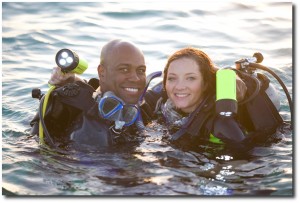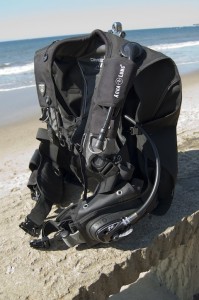Dive training complete. ✓ Check.
Check Out dives signed off by instructor. ✓ Check.
C-card in hand. ✓ Check.

Photo Courtesy of PADI
You’ve just become a certified beginner diver! What do you do next? Stay in the water, of course!
You’ve invested time and money getting certified, plus you love your newfound hobby so why not continue to dive? After all, this is the crucial period that will determine whether you’ll keep diving or just have another “Done that!” item checked off your list.
We are assuming you want to stay wet and enjoy the underwater world so the next step is to gear up!
Many new divers start by buying a mask, fins and snorkel and then just rent the rest of the gear needed. Problem is, if you continue to dive frequently, renting gear for every dive can add up to a lot of money spent on gear that might not be an ideal fit, has been used countless times by other divers, and simply could have gone towards purchasing your own.
Best way to ensure your comfort, safety and convenience is to start investing beyond just a mask, fins and snorkel and start purchasing your own gear. A great place to start is with a wetsuit.
The Wetsuit

Photo Courtesy of Scuba Gear Reports
A properly fitting wetsuit acts as a second skin that helps to keep you warm and comfortable in the water.
You’ll want to make sure your suit fits you just right. A suit that is too tight will make it hard for you to move and breathe properly. While a suit that is too loose will allow too much water in and will therefore become ineffective.
You should buy a wetsuit in person as trying it on will help to ensure it hugs (and lets loose) in all the right places! Also, keep in mind where you like to typically dive as water temperatures can help you determine how thick or thin a wetsuit should be or if more than one is needed.
The Regulator with Instrument Console
Now that you are all suited up, another great piece of gear to purchase is a regulator with an instrument console.
Your regulator system includes a first stage, a primary second stage, a back-up second stage or octopus, and an instrument console with a dive computer to measure depth, air consumption and inform you of your dive profile so you can have a safe dive. This is the heart of your life support system, so owing your own can help you dive confidently knowing your regulator is properly adjusted and up-to-date with its service.
The BC

Photo Courtesy of Scuba Gear Reports
Of course, we all know you need some sort of buoyancy in the water because who wants to constantly fight rising or sinking as you enjoy the sights of the ocean? Your next piece of equipment should be the Buoyancy Compensator.
We placed this one at #3 because you can rent it easily and comfortably so long as you pick up the right size for you. So, it can wait until you’ve got your own wetsuit and reg.
Your BC will be the center of your dive rig; it’s what everything connects to and it allows you to fine-tune your dive set-up, which adds up to a more pleasurable experience.
All the Rest
After you’ve got your basic gear, you will probably find yourself wanting to acquire more equipment as you become a more avid diver. Over time, purchasing your own tank, weights, underwater light, extra dive wrist computer, booties, gloves, safety sausage, dive bag, and accessories is a good idea as the need for them grows. Learn more about “all the rest” now!
Content Provided Compliments of Maduro Dive Fanta-Seas || www.madurodive.com